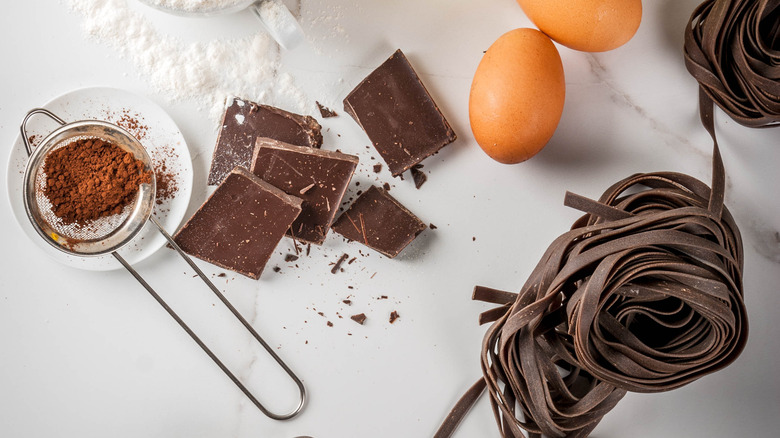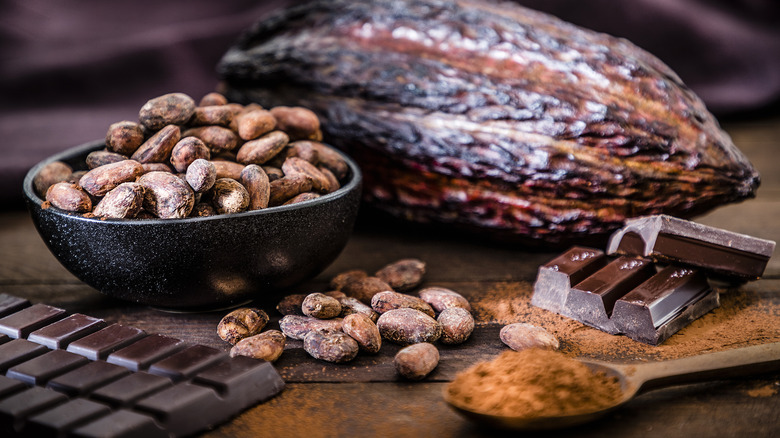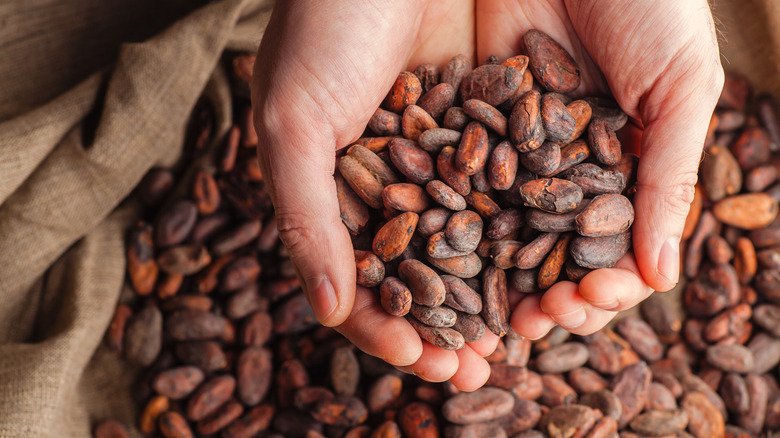Is Chocolate Pasta A Dinner, Dessert, Or Both?
Chocolate pasta might sound like the latest viral food trend spawned by a 20-year-old TikTok star, perhaps as an homage to the syrup-drenched spaghetti in the movie "Elf." On the contrary, cocoa-spiked pasta is even older — and definitely more authentically Italian — than spaghetti and meatballs. In fact, Italians have been adding chocolate to savory dishes since the 16th century, when cocoa beans first made their way to Europe.
"It's only the addition of sugar that makes chocolate sweet," Riccardo Magni of the Italian chocolate producer ICAM told food historian Francine Segan. "Fine dark chocolate, like fine wine, has an amazingly complex taste profile, with hundreds of distinct nuanced aromas and flavors," he added.
More recently, however, recipe developers have been amping up the sugar in chocolate pasta and calling it dessert. To that end, the dish can be eaten for breakfast, lunch, dinner, or as a sweet treat. It all depends on the other ingredients you're adding to the mix.
A little cocoa powder goes a long way
If you want to honor tradition, start your chocolate pasta journey with a savory recipe. For inspiration, you might turn to the fettuccine al cioccolato that graces trattoria menus across Umbria and Tuscany. The dish makes use of cocoa powder, which is added to the flour and salt mixture at the beginning of the dough-making process to give a luscious hue and a subtle complexity to the pasta strands.
In her recipe for tagliatelle al cioccolato, Posie (Harwood) Brien adds mushrooms and rosemary to amplify the savory notes of the unsweetened chocolate. Brien's recipe doesn't call for any sugar, so rest assured that the end result will not taste like dessert.
If sweetness is what you're after, though, there's no rule that says you can't eat chocolate pasta for dessert. Kelsey Nixon's Food Network recipe for chocolate pasta with chocolate hazelnut cream sauce, white chocolate shavings, and fresh berries. Nixon adds chocolate syrup and vanilla to the pasta dough to take the dish from savory to sweet.
If you don't feel up to making your own dough, try your luck at your local specialty grocer — some retailers carry dried varieties of cocoa-infused pasta.
A versatile ingredient
Italians have long used cocoa in many savory dishes, not just pasta. Riccardo Ferrero, the executive chef at Del Cambio Restaurant in Turin, told Francine Segan that unsweetened chocolate can replace butter in "any sauce" as an agent for gloss and shine. It's a key ingredient in sweet and sour agrodolce sauce, which is often served with pork. "Chocolate acts not only as an emulsifier, adding natural thickness to sauces, but also enhances the other flavors," added Tuscan chef Remo Vannini. For that reason, it's also great in salad dressings.
Mole negro is another example of chocolate's savory potential. The traditional Mexican sauce, whose most well-known version can be found in Oaxaca, gets its richness and thickness from Mexican chocolate, such as Abuelita. Unlike chocolate pasta, where cocoa powder is added at the beginning, mole negro recipes incorporate melted chocolate at the very end of the cooking process.


